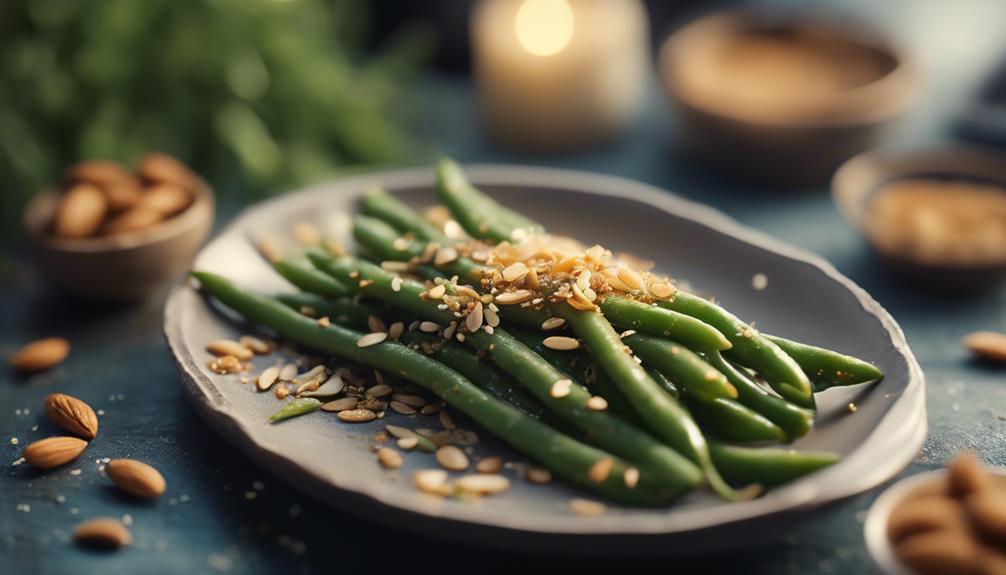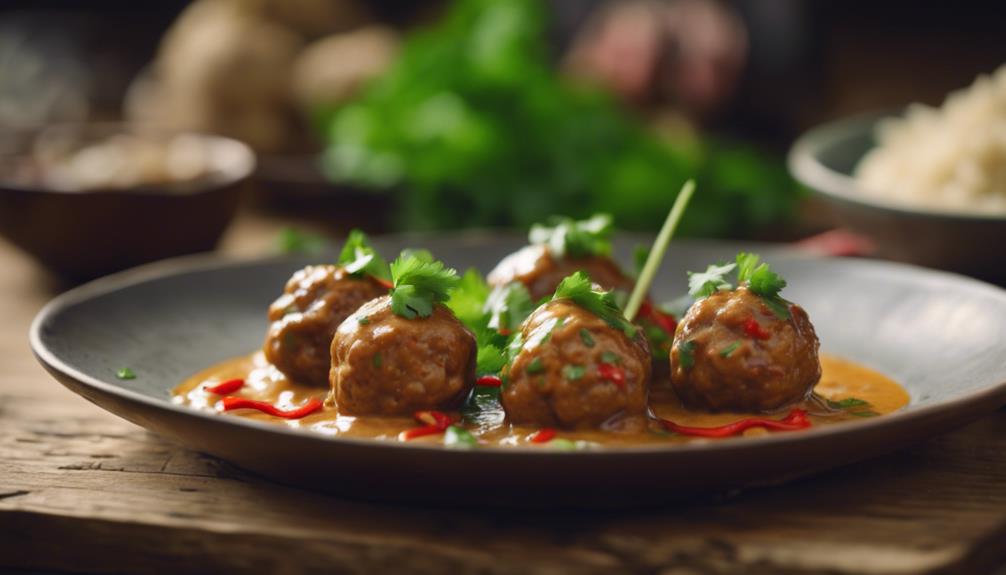Discover the alluring realm of Italian pulled pork, where juicy pork shoulder combines with flavorful Italian herbs such as garlic, rosemary, and fennel, resulting in a distinctive and tasty dinner treat. Cooked slowly to perfection, the meat soaks up a medley of flavors, providing a moist and tender consistency that delights the taste buds. From essential components like San Marzano tomatoes to pivotal seasoning ingredients like balsamic vinegar and aromatic herbs, every aspect blends together to create a dish that distinguishes itself from traditional pulled pork variations. Unveil the enchantment of this fusion cuisine, promising a culinary journey through Italian culinary mastery with each bite.
Key Takeaways
- Italian pulled pork blends tender pork shoulder with aromatic Italian herbs for a flavorful twist.
- Slow-cooking in white wine and tomatoes creates a succulent, juicy texture.
- Customizable with spices like rosemary, thyme, and balsamic vinegar for depth.
- Versatile dish allowing for creative variations with herbs and seasonings.
- Offers a fusion of traditional pulled pork tenderness with vibrant Italian flavors.
Why Italian Pulled Pork?
Discover why Italian pulled pork is a delicious and unique twist on traditional pulled pork recipes. The infusion of Italian flavors such as garlic, rosemary, and fennel gives this dish a Mediterranean flair that sets it apart from the classic version.
By cooking the pork shoulder low and slow, the meat becomes tender and juicy, allowing it to absorb all the rich and savory tastes of the seasonings. The versatility of Italian pulled pork is another reason why it has become a favorite dish for many.
In addition, its customizable nature makes it an excellent choice for feeding a crowd, as you can adjust the flavors and serving styles to suit different tastes. Italian pulled pork offers a delightful fusion of traditional slow-cooked meat with the vibrant and robust essence of Italian cuisine.
Ingredients Needed

To guarantee the Italian Pulled Pork, you'll need a list of essential ingredients such as boneless pork shoulder, garlic, rosemary, white wine, onions, and a blend of Italian spices.
The preparation steps overview will guide you through marinating the pork, slow-cooking it until tender, and shredding it for serving.
Following the cooking time guidelines guarantees that your Italian Pulled Pork turns out perfectly succulent and flavorful.
Essential Ingredients List
Consider including boneless pork shoulder or pork butt as the main ingredient for making Italian Pulled Pork. These cuts of pork are ideal for creating the tender, flavorful meat needed for this traditional Italian recipe.
Alongside the pork, essential ingredients include a blend of aromatic spices such as garlic, rosemary, fennel, and Italian seasoning. Additionally, onions, San Marzano tomatoes, red wine vinegar, and peperoncini are key components that contribute to the rich and savory flavor profile of the dish.
To enhance the taste even further, Girards Olde Venice Italian Dressing can be used in the preparation process. Through slow-cooking the pork to perfection, the flavors meld together, resulting in a mouthwatering dish that can be enjoyed in various ways, making it a versatile and satisfying meal option for any occasion.
Preparation Steps Overview
Start by gathering the necessary ingredients for preparing Italian Pulled Pork, including pork shoulder, garlic, rosemary, white wine, and onions to guarantee a flavorful and aromatic dish.
To begin, you'll need a pork shoulder, ideally bone-in, for the richness it adds to the dish. The garlic and rosemary will infuse the meat with a fragrant taste, while the white wine will contribute acidity and depth to the flavors. Onions will provide a sweet undertone to balance the savory elements.
For the dry rub, consider using a blend of herbs and spices that complement the Italian Pulled Pork recipe you're following.
Once you have all the ingredients assembled, you can proceed to cook the pork shoulder using a Dutch oven or slow cooker, ensuring a tender and juicy result.
This versatile dish can be enjoyed in various ways, such as on pulled pork sandwiches or as the main course for a satisfying meal.
Cooking Time Guidelines
For best results, make sure you have on hand the main ingredients for Italian Pulled Pork, including pork shoulder, San Marzano tomatoes, red wine vinegar, peperoncini, garlic, and onion.
To achieve the authentic Italian flavors and guarantee the pork shoulder turns out tender and fall-apart, utilizing a slow cooker is crucial. The cooking time guidelines for Italian Pulled Pork typically range from 3-4 hours on high or 6-8 hours on low in a slow cooker.
This extended cooking time allows the flavors to meld together, resulting in a dish that isn't only flavorful but also incredibly tender. By cooking the whole pork shoulder slowly, you make sure that the meat becomes so tender it practically falls apart, creating a delightful eating experience.
Additionally, the beauty of this dish lies in its customizability—feel free to add your favorite herbs and spices to tailor the flavors to your liking and make this Italian Pulled Pork recipe your own.
Step-by-Step Cooking Instructions

Begin by seasoning the pork shoulder with Italian herbs and spices before browning it in a hot skillet. Once the pork butt is well seasoned and browned on all sides, transfer it to a slow cooker to continue the cooking process.
Pour a flavorful liquid, such as broth or a mixture of tomatoes and herbs, over the pork to enhance its taste as it simmers. Set the slow cooker to a low setting and let the pork shoulder cook slowly until it becomes tender and easy to shred.
The slow cooker method allows the pork to absorb the seasonings and develop a rich flavor profile characteristic of this traditional Italian dish. After the pork is done cooking, use two forks to shred it into succulent pieces, making sure that each strand is coated in the delicious juices and seasonings.
This step-by-step process guarantees that your Italian pulled pork turns out moist, flavorful, and perfect for any occasion.
Cooking Methods

Consider browning the pork shoulder in a hot skillet before transferring it to the slow cooker for a flavorful Italian Pulled Pork dish.
When preparing Italian Pulled Pork, the braising method is key to achieving a tender and richly flavored result. Here are essential points to keep in mind for the cooking process:
- Choice of Pork Cuts: Opt for pork shoulder or pork butt for their ideal marbling and toughness, which break down beautifully during the braising process.
- Braising Technique: Start by searing the pork in a hot skillet to develop a deep flavor profile, then slow-cook it in liquid to guarantee tenderness and juiciness.
- Interchangeable Cuts: Both pork shoulder and pork butt, originating from the pig's shoulder, work interchangeably in Italian Pulled Pork, offering versatility in your cooking.
Serving Suggestions

Enhance the dining experience by pairing Italian Pulled Pork with a variety of complementary sides and accompaniments. Italian Pulled Pork can be served over pasta, spaghetti squash, or spiralized noodles for a hearty meal.
To elevate the dish, consider serving it alongside sautéed spinach, vinegar coleslaw, garlic mashed potatoes, roasted zucchini, or German potato salad. The versatility of Italian Pulled Pork allows for various serving options, catering to different tastes and occasions.
Leftover Italian Pulled Pork can be transformed into a flavorful pork ragu, offering a new twist to the meal. For those seeking a classic and satisfying meal, try serving the pulled pork on sandwiches or wraps, reminiscent of the beloved Philadelphia-style preparation.
Whether you opt for traditional sides or innovative serving ideas, Italian Pulled Pork proves to be a flexible and delicious dish that can be enjoyed in multiple ways.
Storage Tips

To guarantee the longevity and freshness of your Italian Pulled Pork, here are some practical storage tips:
- Refrigerated for Meal Prepping: Italian Pulled Pork can be refrigerated for 3-4 days, making it an excellent option for meal prepping. Store it in airtight containers to maintain its flavor and moisture.
- Stored in the Freezer for Future Enjoyment: Leftover Italian Pulled Pork can be stored in the freezer for up to 3 months. Divide it into individual portions and freeze them in freezer-safe bags or containers for convenient future use.
- Reheating for Retaining Flavor: When reheating Italian Pulled Pork, warm it in the oven at 250°F for 20-30 minutes. This method helps retain the dish's flavors and textures, ensuring a delicious meal every time.
These storage tips not only help in preserving your Italian Pulled Pork but also enhance its convenience and versatility for your culinary needs.
Additionally, this dish can be easily scaled up for large gatherings, making it a perfect choice for various occasions.
Pro-Tips for Perfect Pulled Pork

When perfecting your Italian Pulled Pork, keep in mind that cooking time is essential for achieving that melt-in-your-mouth texture; low and slow is the way to go.
Seasoning secrets can elevate your pulled pork to the next level; consider experimenting with a blend of herbs, spices, and other flavor enhancers for a unique taste profile.
Mastering these pro-tips will guarantee your Italian Pulled Pork stands out with exceptional tenderness and flavor.
Cooking Time
For best tenderness, slow-cook your Italian Pulled Pork for 3-4 hours on high or 6-8 hours on low. When it comes to preparing this delectable dish, the cooking time is important to achieve that mouthwatering tenderness that defines a perfect pork ragu.
Here are some pro-tips to guarantee your Italian Pulled Pork turns out just right:
- Choose the right cooking vessel: Whether you opt for a slow cooker or Dutch oven, make sure that your boneless pork is cooked in a way that allows it to simmer gently, enhancing the flavors and textures.
- Monitor the cooking time: Check on your pork regularly to make sure it's cooking at the desired pace. Adjust the heat settings if necessary to maintain the ideal cooking temperature.
- Let it rest: Once the cooking time is complete, allow your Italian Pulled Pork to rest for a few minutes before shredding it. This step helps the flavors meld together, resulting in a more flavorful dish.
Seasoning Secrets
Enhance the flavors of your Italian Pulled Pork with these expert seasoning tips. When preparing your pulled pork, remember that seasoning plays an important role in creating a delicious dish. Incorporating classic Italian herbs such as rosemary, thyme, and fennel seeds can elevate the flavor profile of your pork to new heights.
The combination of salt, pepper, and aromatic herbs not only adds depth but also guarantees a well-balanced seasoning profile that will tantalize your taste buds.
Proper seasoning is essential as it helps tenderize the meat and infuse it with rich flavors during the slow cooking process. Italian seasoning secrets involve layering flavors by adding garlic, onions, and a splash of white wine for added complexity.
Flavor Variations to Try

Experiment with different herb and spice combinations like adding basil, oregano, or thyme to the Italian pulled pork for unique flavors.
For a tangy twist, consider incorporating a splash of balsamic vinegar or red wine vinegar.
If you enjoy a bit of heat, try adding crushed red pepper flakes or diced hot peppers to your pulled pork recipe.
These additions can elevate the overall taste profile and provide a delightful kick to your dish.
Add a splash of balsamic vinegar or red wine vinegar for a tangy flavor.
Incorporate crushed red pepper flakes or diced hot peppers for a spicy kick.
Mix in a tablespoon of tomato paste or a dollop of pesto for added richness and complexity.
Italian Pulled Pork Vs Traditional Pulled Pork

Consider how the flavor profiles and cooking methods of Italian Pulled Pork and Traditional Pulled Pork differ to understand the unique characteristics of each dish.
Italian Pulled Pork is distinguished by the infusion of Italian herbs like rosemary, garlic, and fennel seeds, resulting in a savory and aromatic taste. On the other hand, traditional pulled pork, often associated with Southern BBQ, embraces a smoky and sweet flavor achieved through dry rubs or BBQ sauces.
Italian Pulled Pork incorporates ingredients such as white wine, tomatoes, and peperoncini to enhance its taste, while traditional pulled pork leans towards vinegar-based or sweet BBQ sauces for flavor enhancement.
The cooking technique for Italian Pulled Pork involves braising in liquid for tenderness, while traditional pulled pork is typically smoked or slow-cooked over wood for a distinctive taste.
Italian Pulled Pork's versatility allows for incorporation into various Italian-inspired dishes, whereas traditional pulled pork is commonly enjoyed in sandwiches or as a standalone meat dish.
Frequently Asked Questions
What to Serve With Pulled Pork for Dinner?
Looking to serve pulled pork for dinner? Pair it with classic sides like coleslaw, cornbread, or try grilled vegetables for a lighter option. Italian-inspired sides such as garlic bread or roasted veggies enhance the flavors. Explore global flavors too!
How Does Jamie Oliver Make Pulled Pork?
To make pulled pork, Jamie Oliver slow-cooks pork shoulder with a dry rub and liquid in the oven. He sears the meat, then braises it for hours with garlic, rosemary, and white wine, resulting in juicy, tender meat.
What Is Traditionally Served With Pulled Pork?
When you enjoy pulled pork, it's like a flavorful dance party where the main dish busts a move with classic sides like coleslaw, baked beans, and cornbread for a Southern-style meal that'll make your taste buds groove.
What Compliments Pulled Pork?
When it comes to pulled pork, tangy and acidic flavors like tomatoes, vinegar, and peperoncini make great compliments. These flavors enhance the richness of the pork and add a zesty kick to every bite.
What is the Connection Between Italian Pulled Pork and Officina del Gusto Lastra a Signa Dining?
The connection between Italian pulled pork and Officina del Gusto Lastra a Signa dining experience is the expert preparation and flavorsome combination. At Officina del Gusto, the traditional Tuscan cuisine meets modern culinary techniques, resulting in a delightful dining experience. The Italian pulled pork showcases the authentic flavors and quality of this renowned dining establishment.
Conclusion
To sum up, Italian pulled pork is a hearty and delicious dinner option that's sure to satisfy your taste buds.
With its tender meat infused with flavorful Italian seasonings, this dish is a culinary delight that will leave you wanting more.
So why not give it a try and experience the perfect blend of savory and succulent flavors that will surely elevate your dining experience to new heights.
Bon appétit!










